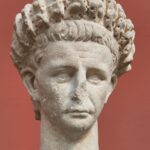According to Suetonius, Emperor Caligula was supposedly commissioned to build a temporary bridge connecting the banks of the Bay of Naples.
Great construction was to be created only so that Caligula could triumphantly cross the bridge. This is how Suetonius describes this idea:
Besides this, he devised a novel and unheard of kind of pageant; for he bridged the gap between Baiae and the mole at Puteoli, a distance of about thirty-six hundred paces, by bringing together merchant ships from all sides and anchoring them in a double line, afterwards a mound of earth was heaped upon them and fashioned in the manner of the Appian Way. Over this bridge he rode back and forth for two successive days, the first day on a caparisoned horse, himself resplendent in a crown of oak leaves, a buckler, a sword, and a cloak of cloth of gold; on the second, in the dress of a charioteer in a car drawn by a pair of famous horses, carrying before him a boy named Dareus, one of the hostages from Parthia, and attended by the entire praetorian guard and a company of his friends in Gallic chariots. I know that many have supposed that Gaius devised this kind of bridge in rivalry of Xerxes, who excited no little admiration by bridging the much narrower Hellespont; others, that it was to inspire fear in Germany and Britain, on which he had designs, by the fame of some stupendous work. But when I was a boy, I used to hear my grandfather say that the reason for the work, as revealed by the emperor’s confidential courtiers, was that Thrasyllus the astrologer had declared to Tiberius, when he was worried about his successor and inclined towards his natural grandson, that Gaius had no more chance of becoming emperor than of riding about over the gulf of Baiae with horses.
– Suetonius, Caligula
However, we do not have any evidence for the existence of this type of structure in the past, and given the reluctant attitude of the senators and higher social strata of Rome to the ruler (including Suetonius), historians consider this story as a myth.







